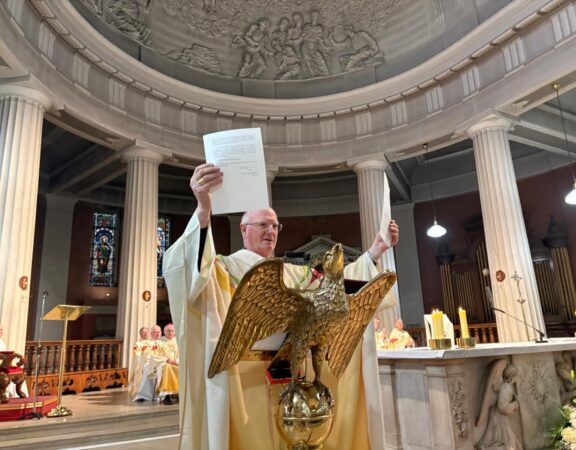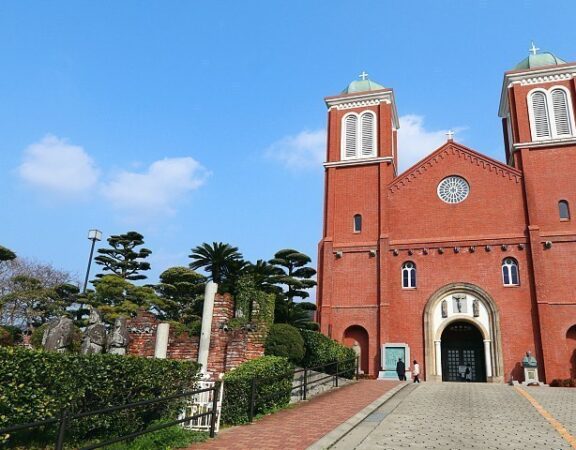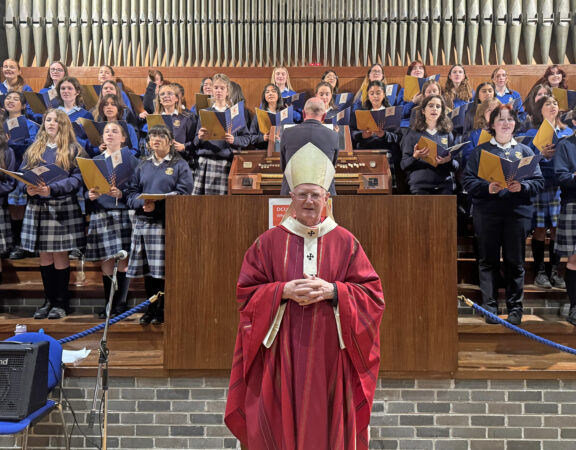Day for Consecrated Life 2013 Homily Notes of Archbishop Martin, Holy Child Church, Larkhill-Whitehall-Santry, 1st February 2013
Once again we gather to celebrate Consecrated Life and to renew our dedication to the variety of charisms represented here this evening and the enormous contribution of Consecrated Life to the Life of the Archdiocese of Dublin. This year we gather significantly on the Feast of Saint Brigid and on the Vigil of the Feast of The Presentation in the Temple.
The Catechism of the Catholic Church notes that “Religious Life derives from the Mystery of the Church”. This means that our gathering here this evening is not just a gathering of individuals, but a unique manifestation of the Church in the very depths of its meaning and it’s Mystery.
It is just over fifty years now since the opening of the Second Vatican Council. So much has taken place in these fifty years. I well remember my early days in Clonliffe fifty years ago, especially at this particular time of year, because in February 1963 Ireland was in the midst of one of the bleakest winters for decades and Clonliffe was a very cold place in more meanings than one. Like many of you I came to formation filled with ideals, not always entirely clear, and found myself in an atmosphere which was, humanly speaking, not quite what I was expecting.
My memory is of a building and a routine, a discipline and a way of life which seemed to have been like that for decades. Even to someone who was not a revolutionary, it all seemed so out of touch with the world from which I had just come, and in which my friends were thriving. But you were not supposed to think that way. Things were done as they had always been done. The Church was unchanging.
We were allowed to watch the opening of the Council on television. We were interested but perhaps not excited and not too sure what the Council really was about. I remember earlier, when the Council was announced, we had begun to hold debates in school about the Council and especially about possibility, which Pope John XXIII had spoken of, of the Council attaining Christian Unity. I must say that the good Catholic education I had received equipped well me to debate against any such ideas.
The Vatican Council however began to fascinate me. The reading in the refectory in Clonliffe was a history of the first Vatican Council and that helped me to understand something of what a Council was and the manner in which doctrinal and pastoral challenges were faced in truly robust discussions at Vatican I (something we sometimes overlook).
That book was followed by The Council and Reunion, by Hans Kung, which we listened to in the refectory with attention and fascination and then went to our weekly conference with our spiritual director who denounced the book as near heresy. Robust discussion was coming alive again in the Church even in Archbishop McQuaid’s seminary.
Over these past months I have been reading a number of books that have appeared to commemorate the fiftieth anniversary of Vatican II. I came across an interesting recent interview with the then private secretary of Pope John XXIII, Archbishop Loris Capovilla, who is still alive today. He recounts how Pope John had been thinking of a Council from the very first days after his election. Pope John was a man of intuition and he was not afraid to think boldly.
His announcement of a Council, made during the Week of Prayer for Christian Unity, just three months after his election, caused surprises and not a little anxiety among some of his collaborators in the Vatican. Pope John was anxious, but he later noted with appreciation the positive tone of his conversations with the few influential Cardinals with whom he shared his intentions before he announced the Council. There are times when consultations about bold decisions work much better when bold decisions have already been taken.
Pope John was fortunate that the Spirit had placed on his path ecumenical leaders who were also deeply committed to Church renewal, people like Archbishop Geoffrey Fisher or Patriarch Athenagoras of Constantinople. The encounter between Archbishop Fisher and Pope John and the later meeting between Patriarch Athenagoras and Pope Paul VI were historic and represented the reattachment of conversation after centuries of separation. It had been over 400 years since Henry VIII broke with Rome and the divisions with the East were even longer.
It was remarkable at the recent Synod of Bishops of the Roman Catholic Church which also celebrated the 50th anniversary of the Vatican Council, to see the normality of the participation at the Synod of the successors of Archbishop Fisher and Patriarch Athenagoras, Archbishop Rowan Williams and Patriarch Bartholomew.
At the Synod, Archbishop Rowan Williams gave a remarkable reflection on the Church now, fifty years after Vatican II. He recalled how the Second Vatican Council did so much “for the health of the Church and helped the Church to recover so much of the energy needed to proclaim the Good News of Jesus Christ effectively in our age”. To the surprise of many he centred his reflection on the theme of contemplation and I believe that theme can be a useful thread for our reflections here this evening on the place of Consecrated Life in the Church and in the world today.
Fifty years after the Council we are called to reflect on how we can derive and use our energy to proclaim the Good News effectively in a world which has changed so much. Archbishop Williams noted: “For so many of my own generation, even beyond the boundaries of the Roman Catholic Church, that Council was a sign of great promise, a sign that the Church was strong enough to ask itself some demanding questions about whether its culture and structures were adequate to the task of sharing the Gospel with the complex, often rebellious, always restless mind of the modern world”
When we talk about the presence of the Church in contemporary culture and in the modern world, we are tempted to speak about how the Church should be present in the structures of the politics and the economics of the modern word, especially through social analysis and social commentary. We would talk also about reform of Church structures and forms of ministry. Archbishop Rowan Williams began with God and how we come to understand God and enter into a relationship with God. In a world in which human advancement is high on our daily agenda he chose to speak of “self-forgetfulness”.
What did he mean by that? Is this a sort of self-denigration or a return to a type of spirituality of self-hatred or self-annihilation or self-repression which many of us would have encountered as part of our formation? His thrust was another one. It was about contemplation as looking towards the light of God revealed in Jesus Christ, in such a way as to be led beyond self. It was about contemplation which leads us beyond “self-generated fantasies of God” with which the modern world might be able live comfortably and beyond forms of religious experience that simply make us feel secure. Faith is in Jesus Christ not a private comfort zone of our own making or a quick compromise with contemporary trends.
Faith in Jesus Christ opens us out beyond human horizons. It offers a yearning for knowledge, but also a yearning for goodness, truth and love which changes people. When faith leads to conformism it has betrayed the very nature of faith. Conformism falsely feels that it has attained certainty. Faith is always a leap into the unknown and a challenge to go beyond our own limits and beyond our own narrow certainties and the distorted understanding that comes from them. Without faith our true self can so easily be undermined by human deception.
Looking at the light of God revealed to us in Jesus Christ is contemplation. Without that sense of self-forgetfulness that comes from contemplation we run the risk, as Archbishop Williams says, “of trying to sustain faith on the basis of an un-transformed set of human habits – with the all too familiar result that the Church comes to look unhappily like so many purely human institutions, anxious, busy, competitive and controlling”.
“Religious Life derives from the Mystery of the Church”. The way we live our lives as religious must witness to those around us to something of the Mystery of the Church and of the sense of hope and meaning which faith alone can offer. Religious life can only be lived truly at the deepest level of human existence. Religious life lived half-heartedly or as routine or superficially drains religious life of what is central to it.
People today are so busy and active and looking for things. They are “anxious, busy, competitive and controlling” as Archbishop Williams noted. They look to the Church not to encounter others equally so “anxious, busy, competitive and controlling” that they are little different to themselves. Our contemporaries – and especially our young contemporaries – seek meaning in life and a hope which can sustain them in the complexities of life today. Our reading from the Letter to the Hebrews recalls how the prophets rejected any form of religion in which undue prominence was given to the external ritual of sacrifice. True religion is about following the obedient self-sacrifice of Jesus himself and true religious life is about our obeying God’s will after the manner of Jesus.
Fifty years after the Second Vatican Council, the place of Consecrated Life in the Church is indeed even more central and the call to perfection and holiness in the Church more urgent. With all our limitations and weaknesses we re-committed ourselves to that path of “self-forgetfulness” which opens a place for the Lord to enter deep into our hearts.







